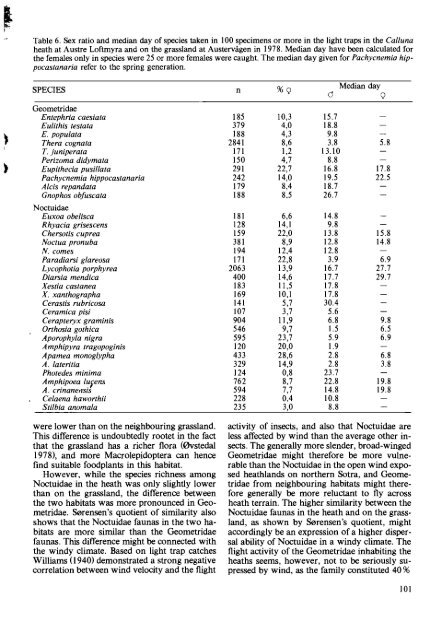o .eg an Jo of En1tomol0lD' - Norsk entomologisk forening
o .eg an Jo of En1tomol0lD' - Norsk entomologisk forening
o .eg an Jo of En1tomol0lD' - Norsk entomologisk forening
- No tags were found...
You also want an ePaper? Increase the reach of your titles
YUMPU automatically turns print PDFs into web optimized ePapers that Google loves.
Table 6. Sex ratio <strong>an</strong>d medi<strong>an</strong> day <strong>of</strong> species taken in 100 specimens or more in the light traps in the Cal/una<br />
heath at Austre L<strong>of</strong>tmyra <strong>an</strong>d on the grassl<strong>an</strong>d at Austervagen in 1978. Medi<strong>an</strong> day have been calculated for<br />
the females only in species were 25 or more females were caught. The medi<strong>an</strong> day given for Pachycnemia hippocast<strong>an</strong>aria<br />
refer to the spring generation.<br />
~<br />
)<br />
SPECIES n %9<br />
cl<br />
Medi<strong>an</strong> day<br />
9<br />
Geometridae<br />
Entephria caesiata 185 10,3 15.7<br />
Eulithis testata 379 4,0 18.8<br />
E. populata<br />
188 4,3 9.8<br />
Thera cognata<br />
2841 8,6 3.8 5.8<br />
T. juniperata 171 1,2 13.10<br />
Perizoma didymata<br />
150 4,7 8.8<br />
Eupithecia pusillata<br />
291 22,7 16.8 17.8<br />
Pachycnemia hippocast<strong>an</strong>aria 242 14,0 19.5 22.5<br />
Alcis rep<strong>an</strong>data 179 8,4 18.7<br />
Gnophos obfuscata 188 8,5 26.7<br />
Noctuidae<br />
Euxoa obelisca 181 6,6 14.8<br />
Rhyacia grisescens 128 14,1 9.8<br />
Chersotis cuprea 159 22,0 13.8 15.8<br />
Noctua pronuba 381 8,9 12.8 14.8<br />
N. comes 194 12,4 12.8<br />
Paradiarsi glareosa 171 22,8 3.9 6.9<br />
Lycophotia porphyrea 2063 13,9 16.7 27.7<br />
Diarsia mendica 400 14,6 17.7 29.7<br />
Xestia cast<strong>an</strong>ea 183 11,5 17.8<br />
X. x<strong>an</strong>thographa 169 10,1 17.8<br />
Cerastis rubricosa 141 5,7 30.4<br />
Ceramica pisi 107 3,7 5.6<br />
Cerapteryx graminis 904 11,9 6.8 9.8<br />
Orthosia gothica 546 9,7 1.5 6.5<br />
Aporophyla nigra 595 23,7 5.9 6.9<br />
Amphipyra tragopoginis 120 20,0 1.9<br />
Apamea monoglypha 433 28,6 2.8 6.8<br />
A. lateritia 329 14,9 2.8 3.8<br />
Photedes minima 124 0,8 23.7<br />
Amphipoea IUfens 762 8,7 22.8 19.8<br />
A. crin<strong>an</strong>e,lsis 594 7,7 14.8 19.8<br />
Celaena haworthii 228 0,4 10.8<br />
Stilbia <strong>an</strong>omala 235 3,0 8.8<br />
were lower th<strong>an</strong> on the neighbouring grassl<strong>an</strong>d.<br />
This difference is undoubtedly rootet in the fact<br />
that the grassl<strong>an</strong>d has a richer flora (0vstedal<br />
1978), <strong>an</strong>d more Macrolepidoptera c<strong>an</strong> hence<br />
find suitable foodpl<strong>an</strong>ts in this habitat.<br />
However, while the species richness among<br />
Noctuidae in the heath was only slightly lower<br />
th<strong>an</strong> on the grassl<strong>an</strong>d, the difference between<br />
the two habitats was more pronounced in Geometridae.<br />
S0rensen's quotient <strong>of</strong> similarity also<br />
shows that the Noctuidae faunas in the two habitats<br />
are more similar th<strong>an</strong> the Geometridae<br />
faunas. This difference might be connected with<br />
the windy climate. Based on light trap catches<br />
Williams (1940) demonstrated a strong n<strong>eg</strong>ative<br />
correlation between wind velocity <strong>an</strong>d the flight<br />
activity <strong>of</strong> insects, <strong>an</strong>d also that Noctuidae are<br />
less affected by wind th<strong>an</strong> the average other insects.<br />
The generally more slender, broad-winged<br />
Geometridae might therefore be more vulnerable<br />
th<strong>an</strong> the Noctuidae in the open wind exposed<br />
heathl<strong>an</strong>ds on northern Sotra, <strong>an</strong>d Geometridae<br />
from neighbouring habitats might therefore<br />
generally be more reluct<strong>an</strong>t to fly across<br />
heath terrain. The higher similarity between the<br />
Noctuidae faunas in the heath <strong>an</strong>d on the grassl<strong>an</strong>d,<br />
as shown by S0rensen's quotient, might<br />
accordingly be <strong>an</strong> expression <strong>of</strong> a higher dispersal<br />
ability <strong>of</strong> Noctuidae in a windy climate. The<br />
flight activity <strong>of</strong> the Geometridae inhabiting the<br />
heaths seems, however, not to be seriously supressed<br />
by wind, as the family constituted 40 %<br />
101

















